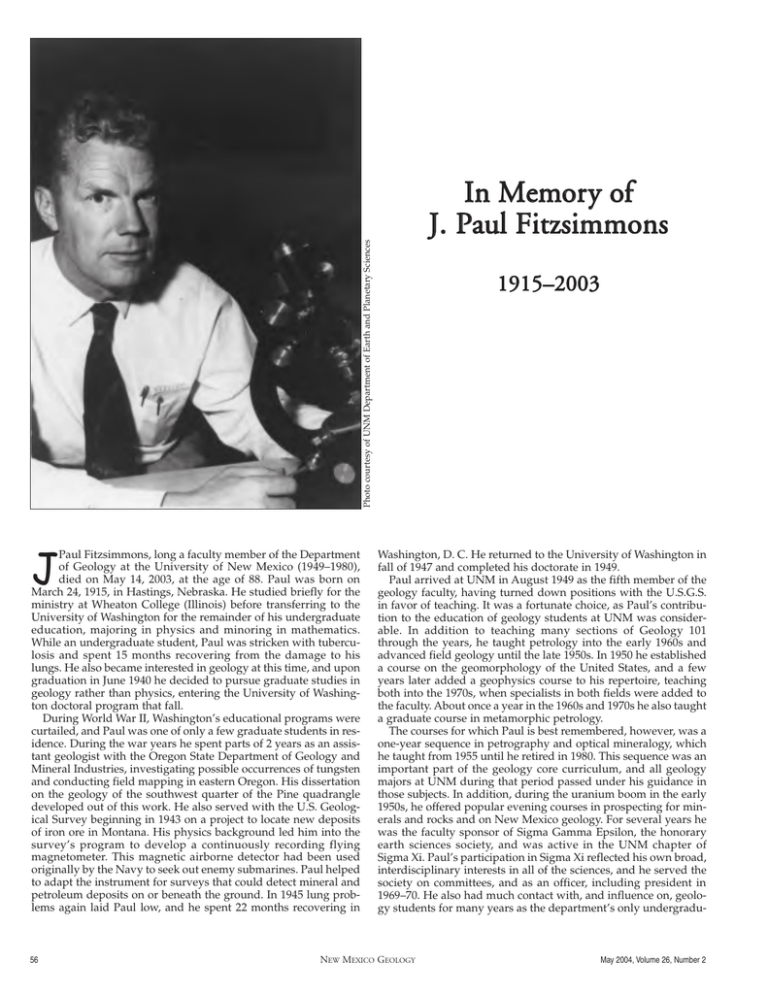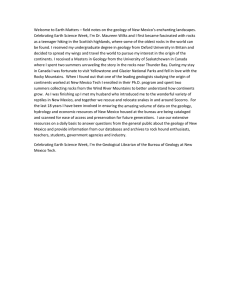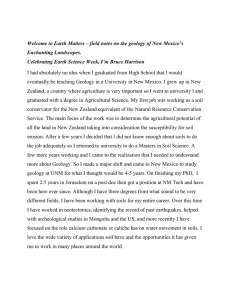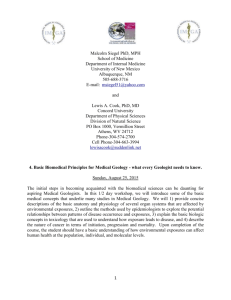J IIn n M Meem
advertisement

Photo courtesy of UNM Department of Earth and Planetary Sciences J Paul Fitzsimmons, long a faculty member of the Department of Geology at the University of New Mexico (1949–1980), died on May 14, 2003, at the age of 88. Paul was born on March 24, 1915, in Hastings, Nebraska. He studied briefly for the ministry at Wheaton College (Illinois) before transferring to the University of Washington for the remainder of his undergraduate education, majoring in physics and minoring in mathematics. While an undergraduate student, Paul was stricken with tuberculosis and spent 15 months recovering from the damage to his lungs. He also became interested in geology at this time, and upon graduation in June 1940 he decided to pursue graduate studies in geology rather than physics, entering the University of Washington doctoral program that fall. During World War II, Washington’s educational programs were curtailed, and Paul was one of only a few graduate students in residence. During the war years he spent parts of 2 years as an assistant geologist with the Oregon State Department of Geology and Mineral Industries, investigating possible occurrences of tungsten and conducting field mapping in eastern Oregon. His dissertation on the geology of the southwest quarter of the Pine quadrangle developed out of this work. He also served with the U.S. Geological Survey beginning in 1943 on a project to locate new deposits of iron ore in Montana. His physics background led him into the survey’s program to develop a continuously recording flying magnetometer. This magnetic airborne detector had been used originally by the Navy to seek out enemy submarines. Paul helped to adapt the instrument for surveys that could detect mineral and petroleum deposits on or beneath the ground. In 1945 lung problems again laid Paul low, and he spent 22 months recovering in 56 I n M e m o r y of J. Paul Fitzsimmons 1 91 5– 2 00 3 Washington, D. C. He returned to the University of Washington in fall of 1947 and completed his doctorate in 1949. Paul arrived at UNM in August 1949 as the fifth member of the geology faculty, having turned down positions with the U.S.G.S. in favor of teaching. It was a fortunate choice, as Paul’s contribution to the education of geology students at UNM was considerable. In addition to teaching many sections of Geology 101 through the years, he taught petrology into the early 1960s and advanced field geology until the late 1950s. In 1950 he established a course on the geomorphology of the United States, and a few years later added a geophysics course to his repertoire, teaching both into the 1970s, when specialists in both fields were added to the faculty. About once a year in the 1960s and 1970s he also taught a graduate course in metamorphic petrology. The courses for which Paul is best remembered, however, was a one-year sequence in petrography and optical mineralogy, which he taught from 1955 until he retired in 1980. This sequence was an important part of the geology core curriculum, and all geology majors at UNM during that period passed under his guidance in those subjects. In addition, during the uranium boom in the early 1950s, he offered popular evening courses in prospecting for minerals and rocks and on New Mexico geology. For several years he was the faculty sponsor of Sigma Gamma Epsilon, the honorary earth sciences society, and was active in the UNM chapter of Sigma Xi. Paul’s participation in Sigma Xi reflected his own broad, interdisciplinary interests in all of the sciences, and he served the society on committees, and as an officer, including president in 1969–70. He also had much contact with, and influence on, geology students for many years as the department’s only undergradu- NEW MEXICO GEOLOGY May 2004, Volume 26, Number 2 ate advisor. Fifteen master’s and one doctoral student received their degrees under his guidance. Paul devoted more time to teaching than to research but contributed to our understanding of New Mexico geology by first reporting (1966) the unusual localized zones of orbicular granite in the Sandia Mountains and aided other geologists and a graduate student in studying these exposures. In addition, in a 1956 paper (with Armstrong and Gordon), he reported the first undoubted Mississippian strata and fossils from northern New Mexico and established the Arroyo Peñasco Formation (now Group) for these strata. Paul was active in the New Mexico Geological Society, editing the 6th (south-central New Mexico, 1955) and 16th (southwestern New Mexico, 1965) field conference guidebooks and serving two terms as treasurer (1955–1957). Some of his published contributions to the guidebooks concerned the natural history, human history, and ornithology of the areas covered. Indeed, Paul’s interests extended beyond geology to all areas of natural history. He once remarked that he thought the most intellectually rewarding study of all would be to focus on a small area of the earth’s surface and learn everything about it, from its geological history and environment, to the plants, animals, and human history that have affected it. Paul’s early interest in and aptitude for languages influenced what was perhaps his major contribution to geological knowledge. In 1958 he began to translate geological literature from the Soviet Union from Russian into English for Plenum Publishing in New York. This was at a time, just after Sputnik, when Soviet society was virtually closed to the West, but their scientific advances were becoming significant and of great interest. As is true even May 2004, Volume 26, Number 2 today, few geologists could read Russian-language literature. For more than 20 years Paul devoted much of his research and writing time to this program, eventually translating more than 20 books and more than 1,200 journal articles from Russian into English. Paul’s efforts made Soviet advances in a wide range of geological and engineering fields known to a large number of Western scientists in a timely manner, soon after the original publications appeared in Russian. While at UNM Paul consulted for several petroleum and engineering companies on various geological problems. He studied, for example, fracturing in subsurface sandstones of the San Juan Basin after detonation of the Gasbuggy nuclear device, for the El Paso Natural Gas Company in 1969. In the early 1970s he worked for the U.S. Park Service in evaluating eight caves in New Mexico, Arizona, and Oklahoma and 30 volcanic areas in New Mexico, Utah, and Arizona as potential national landmarks. When Paul retired from UNM in 1980, he also retired from geology and pursued other interests. A fine pianist, he also had a longtime interest in ornithology. For many years he traveled widely to observe bird migrations and participated in systematic censuses of New Mexico birds, identifying them by sight and by their songs at points along the Rio Grande. Paul’s students invariably remember him as a kind, cultured, gentle man, with a dry sense of humor, who was dedicated to teaching and cared deeply about his students. NEW MEXICO GEOLOGY —Barry S. Kues Professor, Department of Earth and Planetary Sciences University of New Mexico 57







